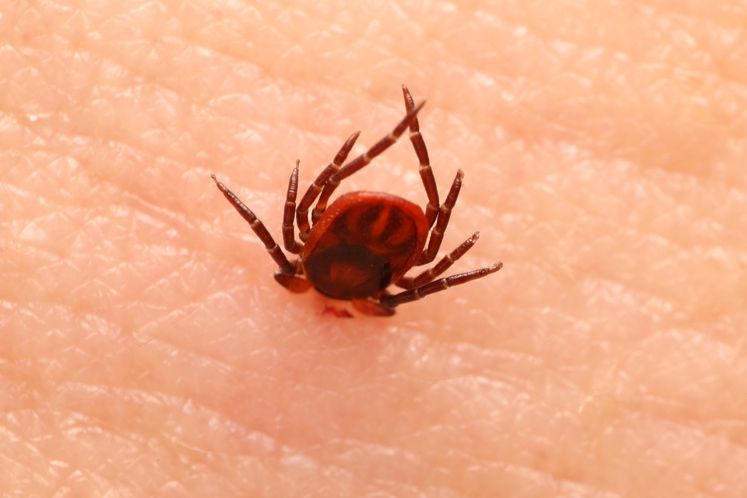
(Vienna, 22 May 2017) Ticks carry a large number of pathogens, some of which can cause serious diseases in humans. As part of a recent study conducted by Anna-Margarita Schötta from the Institute of Hygiene and Applied Immunology and Center for Pathophysiology, Infectiology and Immunology of MedUni Vienna, an inventory has been made of the various pathogens carried by ticks in all parts of Austria. The main findings: around 30% of all ticks in Austria are infected with Borrelia – so more than previously thought –, around 16% with Rickettsia and 4% with the bacterium "Candidatus Neoehrlichia mikurensis". A total of 554 ticks were analysed, from Vienna to Vorarlberg.
Lyme borreliosis is one of the commonest tick-borne infections in the world. Austria sees around 70,000 new cases every year. Borrelia are transferred from the ticks to humans via their sting (colloquially: bite). Treatment with antibiotics is most effective when given as soon as possible after onset of the disease. If the bacterial infection is not detected in good time, it can lead to serious problems such as joint inflammation, painful infections of the nerve roots, meningitis and paralysis.
Austrian States: Ticks most likely to be infected with Borrelia in Vorarlberg
The results of the study show that it is the ticks in Vorarlberg – between two and five locations were tested in each state – that are most commonly infected with Borrelia (33.9%), followed by Upper Austria (28.3%) and Tyrol (27.9%). The risk is lowest in Lower Austria, where only one in five ticks is a potential carrier. Rickettsia (bacteria that can cause typhus fever, inter alia) were primarily identified in ticks in the Vienna area: approximately every second tick is infected with Rickettsia, followed by Carinthia (23.8%) and Lower Austria (18.8%) It was likewise the ticks in Vienna and Tyrol that were most affected by Candidatus Neoehrlichia mikurensis (which causes the infectious disease neoehrlichiosis), at a figure of just over 8%.
Lyme disease: take the tick with you to the doctor!
It is important that the infection is detected quickly. Immunologists at the Institute of Hygiene at MedUni Vienna therefore ask people to come to the Institute as quickly as possible after a tick bite in order to be examined, so that – if they do have an infection – the best possible treatment can be initiated immediately. People should always bring the "common wood tick" (as the tick is also known) with them so that it can be tested for all the different pathogens.
The 2017 tick season has already started. It is primarily people hiking and walking in the forest who are at risk – but equally anyone else who has been lured outdoors by Spring. If a tick has become stuck, you should take hold of it with tweezers as close to the skin as possible and pull with even force to remove it. Keep the tick in a small, well sealed container and bring it with you when you visit the outpatient clinic. If the tick won't come out easily, don't panic, say the experts, and you do not need to go to an emergency department. The tick can be removed the next day at the Lyme disease clinic. (www.meduniwien.ac.at/hai Right-hand button: "Tick bite study – Volunteers sought!"
"Not every tick bite necessarily results in an infection and not every positive Borrelia test means that infection is present. That's the tricky thing," says Gerold Stanek, one of the pioneers of Borrelia research in Vienna. MedUni Vienna researchers are currently working to develop a screening test as part of the EU project "ID-Lyme", so that an actual case of infection can be diagnosed much more quickly than before, at the same time preventing healthy people with Borrelia antibodies in their blood from being given antibiotics unnecessarily.
FSME vaccination doesn't protect against Lyme disease
Incidentally: "An up-to-date vaccination against FSME does not protect against Lyme disease," stresses Hannes Stockinger, Head of the Institute of Hygiene and Applied Immunology and Center for Pathophysiology, Infectiology and Immunology at MedUni Vienna, thereby clearing up a common misconception. As yet, there is no vaccination against Lyme disease.
Service: Applied and Environmental Microbiology
„Approaches for Reverse Line Blot-Based Detection of Microbial Pathogens in Ixodes ricinus Ticks Collected in Austria and Impact of the Chosen Method.“ Anna-Margarita Schötta, Michiel Wijnveld, Hannes Stockinger, Gerold Stanek. 2017, Applied and Environmental Microbiology 83:e00489-17. https://doi.org/10.1128/AEM.00489-17.